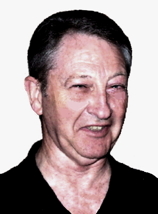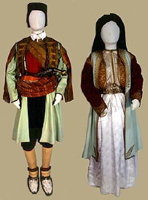
|
Folk Dance Federation of California, South, Inc.
|

|
CLICK IMAGE TO ENLARGE
 Folk dancers are one of the few groups of people who do not have to wait for a national tragedy to learn about a Balkan country. Many, if not most of us, knew that Montenegro was directly adjacent to Kosovo and north of Albania long before the recent front-page tragedies.
Folk dancers are one of the few groups of people who do not have to wait for a national tragedy to learn about a Balkan country. Many, if not most of us, knew that Montenegro was directly adjacent to Kosovo and north of Albania long before the recent front-page tragedies.
Nestled inside a fortress of rugged mountains, Montenegro (Black Mountains), a small republic of Yugoslavia, was a refuge for many against the advancing Turks throughout the reign of the Ottoman Empire. It was, indeed, one of the areas the Turks never conquered, a conspicuous lump in any map of the Turkish empire.
The Montenegrens are among the tallest people of Europe. During the Ottoman reign, the average height for men was about 6'2" and nearly the same for women. Also, we are told that the average life span during those years was about 35 years. Many of the Slavic-named professional basketball players can trace their ancestry back to these mountain guerilla fighters.
They are fiercely proud of their hard-won heritage and a long dagger or two and an enormous revolver were a part of every man's everyday attire, tucked proudly into the front of the sash. They are not hesitant to brandish either and celebrations are deafening with the pistols fired frequently into the air.
The costume accents their natural height. The man's long coat, either white or a pale green, and the women's surcoat create a long vertical silhouette, heightened even more by a proud, erect, even haughty carriage. Heavy gold embroidery borders the man's vest and jacket worn over the coat, with its sleeves swinging jauntily off the shoulders – a style copied from the hated Turks and found throughout that region of the Balkan Peninsula. Soutache (narrow flat decorative braid) stiffens the fabric, laid in intricate designs over the front, back, and sleeves. The woman's white silk blouse, dark skirt, and apron with a short long-sleeved jacket andlong vest – the jacket and vest are of dark red velvet. The surcoat is embroidered in gold.
Dances from Montenegro appear to be rather sedate and dignified, as in Škaljarsko Kolo. One of the Balkan dance videos collected by Dick Crum, Dennis Boxell, and others shows a dance mimicking an eagle, with partners standing facing each other and bounding high into the air, arms outstretched to the sides. Dance games have been observed at festivals, in which the men slice apples thrown into the air by their women partners with their ever-present blade. At other times, the men spin like children to the delight of their admiring women.
In the mid-1980s, the Folk Dance Federation of California embarked on a project to produce a Folk Dance Costume Calendar. The calendar was published for nearly ten years, supported to a large extent by the Costume Committee. A variety of artists submitted renderings of folk costumes with notes about colors, fabrics, and adornment. Mary Vazie was the first and one of the best, her exquisite drawings accurately showing the detail and character. Marion Gault followed with her own excellent renderings in beautiful detail. Others followed for a short time before the calendar project ended.
Used with permission of the author.